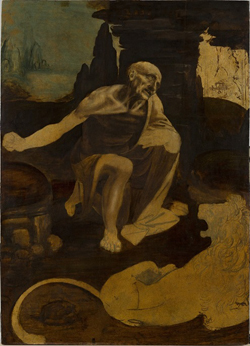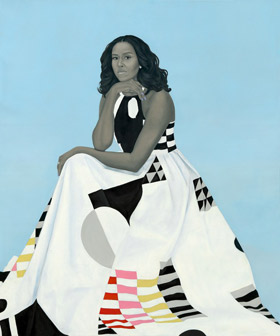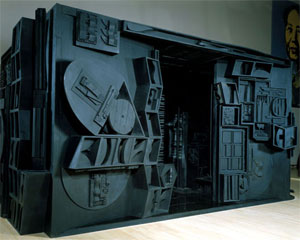All for the Best
John Haberin New York City
Diversity and Growing Pains: 2019 in Review
Every year, I approach the task of a "best of" with trepidation, if at all. This is, after all, the site that argues for criticism as more than picking winners. I try to provide enough insight so that you can pick your own.
This year, though, it seems harder than ever. What if there were no winners in 2019, only more of the same? What if the closest thing to trends, five of them, seem to pull every which way? Oh, sure, your favorite critics in the papers will have their favorites, too, but I could see more the best of intentions than the very best. Allow me, then, briefly to tease them out. Could it be all for the best? 
1. Safety . . .
It says something about 2019 that it contained what I like to call the well-meaning Whitney biennial. The event that people anticipate with hope and fear went down all too easily, even in politically charged work. Its artists most courted controversy, in fact, when they threatened to withdraw—in protest against a museum board member's profits from tear gas and military hardware. And they won, when he blinked and withdrew first. Could it stand for an entire year of small victories? Still, it beats big losers.
Rather than blockbusters, the year had its safe winners, catering to a public that can never get enough of Frida Kahlo, Jean-Michel Basquiat, and pop stars like Leonard Cohen. Retrospectives ran to the modest elegance of Lucio Fontana and Vija Celmins—or the modest inelegance of Mrinalini Mukherjee and Siah Armajani. Younger artists like Rochelle Feinstein, Rachel Feinstein, and Rachel Harrison thrived on their clumsiness and sense of play, while an older new-media artist, Peter Campus, found new ways to play with time. For art history, museums turned to such lesser names as Giovanni Battista Moroni or, with Leonardo da Vinci, to an unfinished painting that New York had seen before. So little by him travels, and on the five hundredth anniversary of his death it would have to do.
Yet it paid off. All these shows brought out sides of art and artists one might never have known. The Guggenheim placed Basquiat in context of street art (and the death of a purported street artist), to ask how well he fit the bill. The Frick found in Moroni the many aspects of Renaissance portraiture, while the Met raised crucial questions about "Hidden Portraits" and Leonardo's unfinished art. However did he get away with it—and what does that say about an artist known at once for charm and achievement and for retreat into isolation? Like his subject, a church elder and ascetic in the desert, he had a talent for going to extremes.
2. . . . And other voices
Of course, the Biennial had everything to do with politics, in a most political year. Exhibitions brought the strident politics of Hans Haacke at the New Museum and Sue Coe at MoMA PS1, but not only that. They also broadened the pursuit of diversity. Now that diversity has become an imperative, can it still be a challenge? Maybe not in the commercial context of the 2019 art fairs, not even with the many women among single-artist booths at the ADAA Art Show. Welcome it all the same.
 African American art had room for telling hands from Wilmer Wilson IV and telling faces from Amy Sherald in Chelsea. It had room, too, for telling voices from Nari Ward, whose New Museum retrospective asked who speaks for "we the people." Kehinde Wiley had his touristy rejoinder to Confederate monuments, but Betye Saar means more than mass entertainment with her Liberation of Aunt Jemima. While the Morgan Library brought the storytelling magic of Duane Michals, a gay white male, black photographers brought their elusive histories as well. Roy DeCarava in Chelsea left a portrait of the jazz age, while John Dowell found the spirit rising in black churches even in the age of cotton, like Willie Birch twenty years before. After John Edmonds and Paul Mpagi Sepuya in the Whitney Biennial, Alvin Baltrop at the Bronx Museum gave gay African Americans a more explicit history.
African American art had room for telling hands from Wilmer Wilson IV and telling faces from Amy Sherald in Chelsea. It had room, too, for telling voices from Nari Ward, whose New Museum retrospective asked who speaks for "we the people." Kehinde Wiley had his touristy rejoinder to Confederate monuments, but Betye Saar means more than mass entertainment with her Liberation of Aunt Jemima. While the Morgan Library brought the storytelling magic of Duane Michals, a gay white male, black photographers brought their elusive histories as well. Roy DeCarava in Chelsea left a portrait of the jazz age, while John Dowell found the spirit rising in black churches even in the age of cotton, like Willie Birch twenty years before. After John Edmonds and Paul Mpagi Sepuya in the Whitney Biennial, Alvin Baltrop at the Bronx Museum gave gay African Americans a more explicit history.
When it comes to diversity, can art still discover more? MoMA PS1 gave over the building to the Mideast wars, while its parent institution reflected "Sur Moderno." Others turned to Algeria and emerging Latin American art. With woman, though, the greatest rewards came with an emphasis on anything but youth. Big shows came late to Celmins, Simone Fattal, Zilia Sánchez, and Bettina. Anni Albers can now stand beside her partner in marriage and the Bauhaus, Josef Albers—whose abstract mural returned to midtown this year as ell.
3. Growing . . .
Life is not all identity, justice, and charity. Diversity, too, has a dark side—the market, with its pressure to discover hidden corners of the canon and the latest thing. I could swear that women have carried the brunt of the revival of expressive realism and abstract painting, marvelously. Sometimes, though, you just want to scream enough. Hudson Yards opened, towering over the High Line and lost opportunity of Penn Station. Its luxuriant ugliness extends even to the dark recesses and high prices of its arts space, The Shed.
Nearby galleries are growing at the high end, promising multiplexes and empires. And the Lower East Side now extends at least a mile in every direction, daring you to take it all in. It has also spawned an enclave on the east end of Tribeca. With escapees from Chelsea as well as downtown, it defies any notion of fringe players and fringe art. Ruthless museum expansions continue, too, whether from venality or necessity. While the Studio Museum is still a work in progress, and the Morgan Library is replacing the roof and pointing, expect a new home for photography at ICP in the new Essex Street market in no time.
Still, that same trend is producing welcome spaces for art and a warmer welcome. Both appear in the first monster Chelsea gallery, Pace, and the LMCC Art Center on Governors Island. They appear even more in MoMA's reopening, as way more than an investment in midtown real estate. Thanks to Diller Scofidio + Renfro with Gensler, it has more spaces free of charge and more space for the collection. The dreadful 2004 atrium no longer towers over its responsibility to the public and to art. It may still look like an airport or shopping mall, through no fault of the new architects, but the airport has acquired some amentias and the mall some decent choices.
4. . . . And shrinking pains
Not that everything is growing—and not that refusal to grow is all to the good. The down side of competition is failure. One can hardly complain about too few art fairs, not with an entire fair for street art, but at least one fair has decamped for winter in Miami and another for summer on Governors Island. The Moving Image art fair is gone entirely, perhaps for good. Galleries have it worse. They may try to spin their disappearance as a "hybrid model" of exhibitions and private dealing, but one may never hear from most of them again.
Everyone will have favorites among the lost and lamented. Everyone will have surprises in that list, too, as dealers that expanded in the flush of success pay the price. Bushwick has paid the price more than any other neighborhood at that. Some galleries closed in expectation of an L train shutdown—much as work on the L train some years ago contributed to the demise of galleries in Williamsburg. And then service was, more or less, restored. I doubt that many of those galleries are second guessing themselves, but their artists may.
Museums, too, may pay the price of success. Not even record attendance can save the Met from rising admission prices—to a fixed fee for visitors from out of state. It will also abandon the Met Breuer before its lease from the Whitney Museum is out. A restored New York landmark now has an uncertain fate. It will offer a short-term home for the Frick Collection as the Frick Madison as it expands as well, but then wait and see. One can only hope that the Frick, too, will not pay a steep price.
5. Only collect
Remember, though: this is not all about winners and losers—not when it comes to artists and not when it comes to the future. A museum's paring back can bring a renewed focus on the permanent collection, as at MoMA. It can bring a fresh eye on that collection as well. The Modern's new layout throws modern art movements to the winds, while connecting generations, races, genders, and media. Critics have gone wild, and I could only urge a more cautious celebration.
MoMA still manages to open with more temporary exhibitions than you or I could see in a day. As if to speak to its growth, Pope.L uses the occasion of his to crawl once again across Manhattan. Still, it is not alone in its incisive paring back. The Whitney Museum keeps rehanging its collection, to find more and more aspects of American art. The Guggenheim Museum turned the entire ramp over to artists as guest curators of the collection, while the Museum of Modern Art has begun a series for guest curators as well, starting with Amy Sillman— and it took time out this spring, before closing for expansion, to set out its collection of Joan Miró. The Met rehung its "Epic Abstraction" and the golden age of Dutch art (with a fine compliment in the Eveillard collection of Dutch drawings at the Morgan Library).
and it took time out this spring, before closing for expansion, to set out its collection of Joan Miró. The Met rehung its "Epic Abstraction" and the golden age of Dutch art (with a fine compliment in the Eveillard collection of Dutch drawings at the Morgan Library).
The revival of painting is a kind of recovery, too. That includes another feature of these year-end recaps—the show I most wish that I had found the words to review. Chelsea found Jasper Johns still working every bit with his own hand and, in his imagery, confronting mortality. Why did he find that in a photograph from the Vietnam War? I am not at all sure, and he disguised the image while making a point of it. That same two-step of disguise and revelation, of himself and the process of painting, applies to everything he does—and I just hope that he is still the greatest living artist, meaning still alive, for his two-museum retrospective next fall.

Of course, this site has reviewed pretty much all this and more at length. Jasper Johns ran at Matthew Marks through April 6, 2019. Other dates and locations appear with fuller reviews, with links here. You can now also see year-end reviews for 2007, 2008, 2009, 2010, 2011, 2012, 2014, 2015, 2016, 2017, 2018, 2020, 2021, 2022, and 2023.




